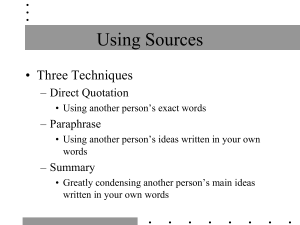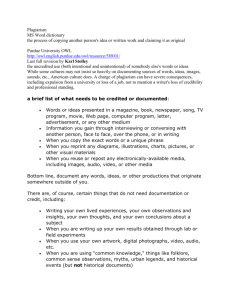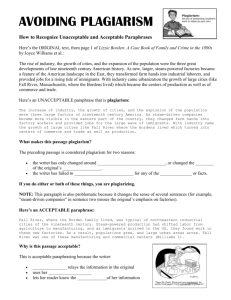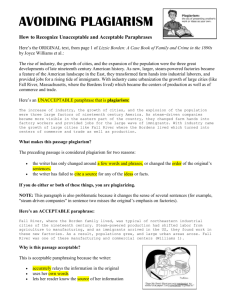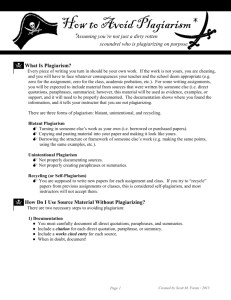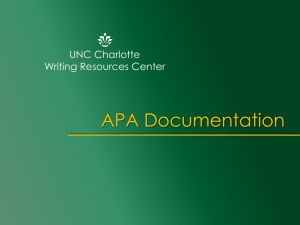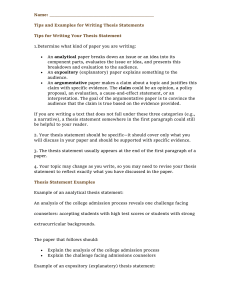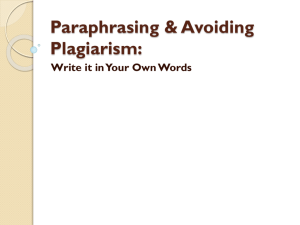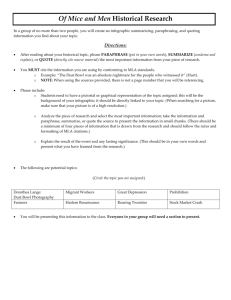How to Avoid Plagiarism
advertisement
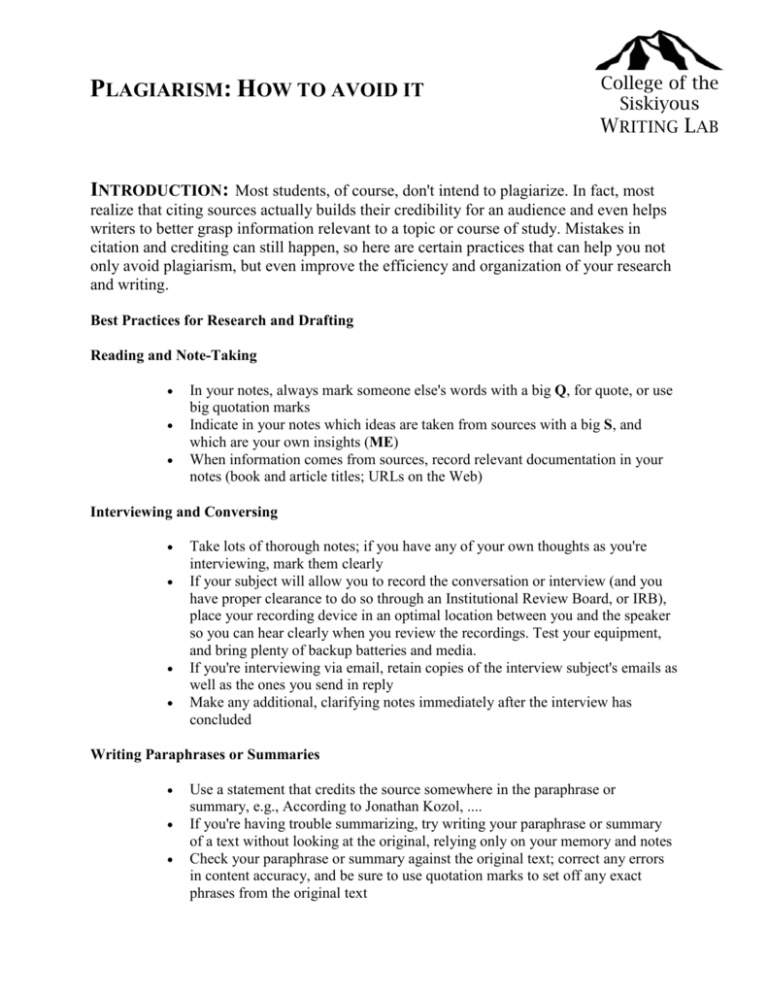
PLAGIARISM: HOW TO AVOID IT College of the Siskiyous WRITING L AB INTRODUCTION: Most students, of course, don't intend to plagiarize. In fact, most realize that citing sources actually builds their credibility for an audience and even helps writers to better grasp information relevant to a topic or course of study. Mistakes in citation and crediting can still happen, so here are certain practices that can help you not only avoid plagiarism, but even improve the efficiency and organization of your research and writing. Best Practices for Research and Drafting Reading and Note-Taking • • • In your notes, always mark someone else's words with a big Q, for quote, or use big quotation marks Indicate in your notes which ideas are taken from sources with a big S, and which are your own insights (ME) When information comes from sources, record relevant documentation in your notes (book and article titles; URLs on the Web) Interviewing and Conversing • • • • Take lots of thorough notes; if you have any of your own thoughts as you're interviewing, mark them clearly If your subject will allow you to record the conversation or interview (and you have proper clearance to do so through an Institutional Review Board, or IRB), place your recording device in an optimal location between you and the speaker so you can hear clearly when you review the recordings. Test your equipment, and bring plenty of backup batteries and media. If you're interviewing via email, retain copies of the interview subject's emails as well as the ones you send in reply Make any additional, clarifying notes immediately after the interview has concluded Writing Paraphrases or Summaries • • • Use a statement that credits the source somewhere in the paraphrase or summary, e.g., According to Jonathan Kozol, .... If you're having trouble summarizing, try writing your paraphrase or summary of a text without looking at the original, relying only on your memory and notes Check your paraphrase or summary against the original text; correct any errors in content accuracy, and be sure to use quotation marks to set off any exact phrases from the original text • • Check your paraphrase or summary against sentence and paragraph structure, as copying those is also considered plagiarism. Put quotation marks around any unique words or phrases that you cannot or do not want to change, e.g., "savage inequalities" exist throughout our educational system (Kozol). Writing Direct Quotations • • • • • • Keep the source author's name in the same sentence as the quote Mark the quote with quotation marks, or set it off from your text in its own block, per the style guide your paper follows Quote no more material than is necessary; if a short phrase from a source will suffice, don't quote an entire paragraph To shorten quotes by removing extra information, use ellipsis points (...) to indicate omitted text, keeping in mind that: o Three ellipsis points indicates an in-sentence ellipsis, and four points for an ellipsis between two sentences To give context to a quote or otherwise add wording to it, place added words in brackets, []; be careful not to editorialize or make any additions that skew the original meaning of the quote—do that in your main text, e.g., o OK: Kozol claims there are "savage inequalities" in our educational system, which is obvious. o WRONG: Kozol claims there are "[obvious] savage inequalities" in our educational system. Use quotes that will have the most rhetorical, argumentative impact in your paper; too many direct quotes from sources may weaken your credibility, as though you have nothing to say yourself, and will certainly interfere with your style Strategies for Avoiding Plagiarism: • • • Put in quotation marks everything that comes directly from the text, especially when taking notes during the research phase. Paraphrase, but be sure you are not just rearranging or replacing a few words. Instead, read over what you want to paraphrase carefully; cover up the text with your hand, or close the text, so you can’t see any of it. Write out the idea in your own words without peeking. Check your paraphrase against the original text to be sure you have not accidentally used the same phrases or words, and the information is accurate. How to Recognize Unacceptable and Acceptable Paraphrases Here’s the ORIGINAL text from page 1 of Lizzie Borden: A Case Book of Family and Crime in the 1890s by Joyce Williams et al.: The rise of industry, the growth of cities, and the expansion of the population were the three great developments of late nineteenth century American history. As new, larger, steam-powered factories became a feature of the American landscape in the East, they transformed farm hands into industrial laborers, and provided jobs for a rising tide of immigrants. With industry came urbanization, the growth of large cities (like Fall River, Massachusetts, where the Bordens lived) which became the centers of production as well as of commerce and trade. UNACCEPTABLE paraphrase that is plagiarism: The increase of industry, the growth of cities, and the explosion of the population were three large factors of nineteenth century America. As steam-driven companies became more visible in the eastern part of the country, they changed farm hands into factory workers and provided jobs for the large wave of immigrants. With industry came the growth of large cities like Fall River where the Bordens lived which turned into centers of commerce and trade as well as production. The preceding passage is considered plagiarism for two reasons: • The writer has only changed around a few words and phrases, or changed the order of the original’s sentences. • The writer has failed to cite a source for any of the ideas or facts. If you do either or both of these things, you are plagiarizing. NOTE: This paragraph is also problematic because it changes the sense of several sentences (for example, "steam-driven companies" in sentence two misses the original’s emphasis on factories). ACCEPTABLE paraphrase: Fall River, where the Borden family lived, was typical of northeastern industrial cities of the nineteenth century. Steam-powered production had shifted labor from agriculture to manufacturing, and as immigrants arrived in the US, they found work in these new factories. As a result, populations grew, and large urban areas arose. Fall River was one of these manufacturing and commercial centers (Williams 1). This is acceptable paraphrasing because the writer: • • • Accurately relays the information from the original. Uses her own words. Lets her reader know the source of her information by citing the source. Here’s an example of quotation and paraphrase used together, which is also ACCEPTABLE: Fall River, where the Borden family lived, was typical of northeastern industrial cities of the nineteenth century. As steam-powered production shifted labor from agriculture to manufacturing, the demand for workers "transformed farm hands into industrial laborers," and created jobs for immigrants. In turn, growing populations increased the size of urban areas. Fall River was one of these hubs "which became the centers of production as well as of commerce and trade" (Williams 1). This is acceptable paraphrasing because the writer: • • • Records the information from the original passage accurately. Gives credit for the ideas in this passage. Indicated which part is taken directly from her source by putting the passage in quotation marks and citing the page number and author. Adapted from Indiana University 2004 and Purdue OWL 2011
